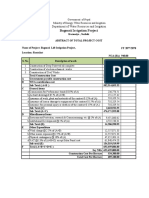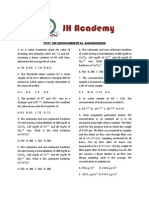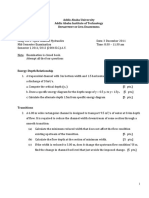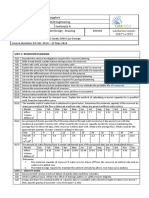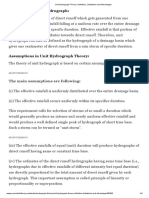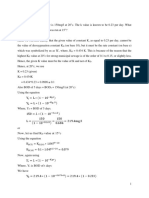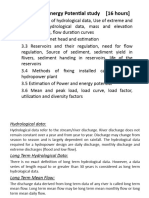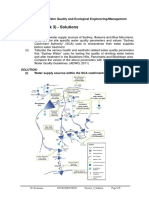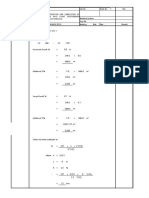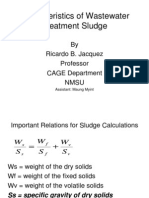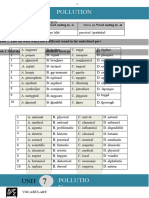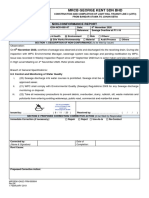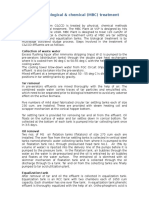Ch. 3 Numericals
Ch. 3 Numericals
Uploaded by
MriduCopyright:
Available Formats
Ch. 3 Numericals
Ch. 3 Numericals
Uploaded by
MriduCopyright
Available Formats
Share this document
Did you find this document useful?
Is this content inappropriate?
Copyright:
Available Formats
Ch. 3 Numericals
Ch. 3 Numericals
Uploaded by
MriduCopyright:
Available Formats
1.
A typical wastewater has a value of base 10 rate
constant at a temperature, 200C is 0.1/day. Find its
value at 300C.
Solution:
We know that,
Value of θ= 1.056 for temperature range 200C to 300C.
Now putting the value of k20, θ and T in above equation
5/16/2022 Er. Basant Lekhak 97
2. Determine ultimate BOD for a sewage having 5-day BOD at 20°C as 180 ppm. Assume the base 10
rate constant K = 0.1 per day.
Solution
we have
BODt = yt = L0 (1 - 10-Kt)
Given BOD5 = y5 = 180 ppm ; K = 0.1 per day ; t= 5 days
Thus by substitution, we get
180 = L0 (1 - 10-5x 0.1)
L0 = 263.23 ppm (or mg/l)
3. Determine 2-day BOD for the sewage of the above question. Also find the remaining 6 day-BOD.
For 2-day BOD sewage
yt = L0 (1 - 10-Kt)
We have, t = 2 days; L0= 263.23 ppm; and K = 0.1 per day
Thus by substitution, we get
yt = L0 (1 - 10-Kt)
or., y2 = 263.23(1 – 10-0.1 x 2)
= 263.23 (1 - 0.6309)
= 97.16 ppm (or mg/l)
5/16/2022 Er. Basant Lekhak 98
For remaining 6 day-BOD
Lt= L0(10-kt)
Or, Lt = 263.23(10-0.1 x 6)
Or, Lt= 66.12 mg/l
4. A sample of sewage has 4-day 20°C BOD value of as 70% of the ultimate BOD. Find the base 10 rate constant
K.
Solution
We have
BODt = yt = L0 (1 - 10-Kt)
Given BOD4 = y4 =0.7 yu = 0.7 L0 ; t= 4 days
BOD4 = y4 = L0 (1 - 10-Kx4)
Or, 0.7L0 = L0 (1 - 10-Kx4)
Or, K = 0.131 per day
5/16/2022 Er. Basant Lekhak 99
5. If BOD3 at 150C is 220mg/l, find BOD7 at 250C.
Solution:
• BOD3=220mg/l at 150C BOD7=? at 250C
• Let K20= 0.1 day-1 (base 10)
• Now 𝐾 =𝐾 𝜃 = 0.1 × 1.135 = 0.053
• 𝑦 = 𝑙 1 − 10
• Put the value of t= 3 day, y3=220mg/l and K= 0.053 per day at 150C in above equation
. ×
• 220 = 𝑙 1 − 10
• 𝑙 = 717.61mg/l
• 𝐾 =𝐾 𝜃 = 0.1 × 1.056 = 0.131
• 𝑦 = 𝑙 1 − 10
• Put the value of t= 7 day, l0=717.61mg/l and K= 0. 131 per day at 250C in above equation
. ×
• 𝑦 = 717.61 1 − 10
• 7day BOD at 25 C, 𝑦 = 𝐵𝑂𝐷 = 𝟔𝟑𝟎. 𝟕𝟒𝒎𝒈/𝒍
5/16/2022 Er. Basant Lekhak 100
6. If the five-day BOD at 200C is 280 mg/l and one day,
BOD at 200C is 111.80 mg/l. Calculate the rate reaction
constant k at 200C and 7 day BOD at 250C.
5/16/2022 Er. Basant Lekhak 101
Dividing equation (1) by equation (2) we get
• By hit and trial we get value of K=0.19 at 200C
Putting the value of K20 in equation (1), we get
( ∗ . )
5/16/2022 Er. Basant Lekhak 102
Now calculate K25 by using expression given
below
•
•
•
•
5/16/2022 Er. Basant Lekhak 103
7. The BOD of a sewage incubated for one day at 30°C has been found to be 120mg/l. What will be
the 5-day BOD at 20°C? Assume K = 0.12 per day at 20°C.
Solution
we have
KT =K20 𝜃 (T - 20)
Since the temperature range is 20° to 30°C, the value of 𝜃 may be taken as 1.056.
Given, K20 = 0.12 per day and T = 30°C
Thus by substitution, we get
K30 =0.12 x 1.056(30 - 20)
K30 = 0.207 per day
we have
yt = L0 (1 - 10-Kt)
Given, t = 1 day ; y1 = 120 mg/l at 30°C and K = 0.207 per day at 30°C
Thus by substitution, we get
120 = L0(1 – 10-0.207 x 1)
Or, 120 = L0(1 - 0.6207)
Or, L0 = 316.4 mg/l
This is the value of ultimate BOD which does not depend on temperature of incubation.
5/16/2022 Er. Basant Lekhak 104
Thus again applying equation for yt at 20°C, we
have
yt = L0 (1 - 10-Kt)
Given, t = 5 days ; K = 0.12 per day at 20°C; and L0
= 316.4 mg/ l.
Thus by substitution, we get
y5 = 316.4 (1 - 10-0.12 x 5)
y5= 316.4 (1 - 0.2512)
y5 = 236.9 mg/1
Thus BOD5 at 20°C = 236.9 mg/l (or ppm)
5/16/2022 Er. Basant Lekhak 105
8. A wastewater sample was incubated at 25℃ and the following observations were made: 5-day
BOD of sample= 200 mg/l, 11-day BOD sample= 268 mg/l. Calculate the 6 day BOD at 15 ℃.
Solution,
We have
yt = L0 (1 - 10-Kt)
Given, t = 5 day ; y5 = 200 mg/l at 25°C and K20
𝑡𝐾
y5= L0 (1 - 10- )
5𝐾
Or, 200= L0(1 - 10- )
200
Or, L0 (1 − 10− ) ………………………(1)
=
Again
Given, t = 11 day ; y5 = 268 mg/l at 25°C and K25
𝑡𝐾
y11= L0 (1 - 10- )
11𝐾
Or, 268= L0(1 - 10- )
putting value of L0 from (1)
200 11𝐾
Or, 268= (1 − 10− −
) 𝑥(1 − 10 )
Or, K25= 0.1015
And from equation (1)
L0= 290.19mg/l
5/16/2022 Er. Basant Lekhak 106
KT =K20 𝜃 (T - 20)
Since the temperature range is 25° to 20°C, the value of 𝜃 may be taken as 1.056.
Given, K25 = 0.1015 per day and T = 25°C
Thus by substitution, we get
K25 =K20 x 1.056(25 - 20)
0.1015 = K20 x 1.056(25 - 20)
K20 = 0.0773 per day
Again,
KT =K20 𝜃 (T - 20)
Since the temperature range is 20°C to 15°C, the value of 𝜃 may be taken as 1.135
Given, K25 = 0.0773 per day and T = 15°C
Thus by substitution, we get
K15 =K20 x 1.056(T - 20)
Or, K15 = 0.0773 x 1.135(15 - 20)
K15 = 0.041 per day
5/16/2022 Er. Basant Lekhak 107
For 6 day BOD at 15
yt = L0 (1 - 10-Kt)
Given, t = 6 days ; K = 0.041 per day at 15°C;
and L0 = 290.197 mg/ l.
Thus by substitution, we get
y6 = 290.197 (1 - 10-0.041 x 6)
or, y6 = 125.49 mg/l
Thus BOD5 at 15°C = 125.49 mg/l (or ppm)
5/16/2022 Er. Basant Lekhak 108
9. For a sample of sewage 5-day BOD at 20℃ is 250mg/l and it is 67% of the ultimate BOD. What
will be its 4-day BOD at 30 ℃?
Solution
BOD5= y5 = L0 (1 - 10-5K)
Given y5= 250 mg/l at 20℃
also y5= 67% of L0
Therefore, L0=
.
Or, L0= = 373.1 𝑚𝑔/𝑙
.
Thus by substitution, we get
250= 373.1(1-10-5K)
0r, K= 0.0963 per day for 20℃
We know
KT =K20 𝜃(T - 20)
Since the temperature range is 20° to 30°C, the value of 𝜃 may be taken as 1.056
Given, K20 = 0.963 per day and T = 30°C
Thus by substitution, we get
K30 =0.963 x 1.056(30 - 20)
Or, K30= 0.166 per day
5/16/2022 Er. Basant Lekhak 109
Again,
yt = L0 (1 - 10-Kt)
Given, t = 4 days ; K = 0.166 per day at 30°C;
and L0 = 373.1 mg/ l.
Thus by substitution, we get
y4 = 373.1 (1 - 10-0.166 x 4)
y4= 373.1 (1 - 0.2168)
y4 = 292.2 mg/1
Thus BOD5 at 20°C = 236.9 mg/l (or ppm)
5/16/2022 Er. Basant Lekhak 110
10. The domestic sewage of a town was tested for total solids and follow results were obtained:
• Volume of sample of sewage = 1000 ml
• Weight of solids after evaporation of liquid = 0.905 gm
• Weight of dry residue after ignition = 0.462 gm
Determine in ppm (i) total solids, (ii) fixed solids, and (iii) volatile solids.
Solution:
(I) Total solids =
. ( )
Total solids = = 𝑥 1000
( )
Total solids = 905 mg/l = 905 ppm
(ii) Fixed solids
. ( )
Fixed solids = 𝑥 1000
( )
=462 mg/l = 462 ppm
(iii) Volatile solids
Volatile solids = (Total solids — Fixed solids)
Volatile solids = (905 — 462)
= 443 ppm
5/16/2022 Er. Basant Lekhak 111
11. The test of a sewage of a town for total solids indicated the following particulars.
• Weight of the dry crucible = 40gm
• Volume of sample taken =100ml
• Weight of crucible with residue obtained after evaporation = 40.068 gm
• Weight of crucible with dry residue obtained after ignition = 40.033 gm’
Determine (i) total solids, (ii) volatile solids, and (iii) fixed solids.
Solution
Volume of sample = 100 ml
Weight of dry crucible, W1 = 40.0 gm = 40000 mg
Weight of crucible with residue obtained after evaporation, W2 = 40.068 gm
=40068 mg
We have
Total solids = 𝑥 1000
Total solids = 𝑥 1000
Total solids = 680 mg/l= 680 ppm
5/16/2022 Er. Basant Lekhak 112
Weight of dry residue obtained after ignition
W3= 40.033 gm = 40033 mg
Volatile solids =
=
= 350 mg/l = 350 ppm
Fixed solids= Total solids in mg/l— Volatile solids in mg/I
= 680-350
= 330 mg/l = 330 ppm
5/16/2022 Er. Basant Lekhak 113
We have , BOD (mg / l) =
%
(a) Percentage dilution =
=1
DO of the diluted sample prior to incubation, DO1 = 8.7 mg/l
DO of the diluted sample at the end of incubation, DO2 = 4.7
mg/l
BOD (mg / l) =
%
BOD (mg / l) =
BOD (mg/l) = 400 mg/l
(b) 5-day BOD contained in 1.5 million liters of sewage
(Kg/lit ) x 1.5 x 106 (lit)
= 600 kg
5/16/2022 Er. Basant Lekhak 114
12. In a BOD test, 4 ml of raw sewage was
diluted to 400 ml and the DO concentration of
the diluted sample at the beginning of the test
was 8.7 mg/l and Of the end of 5 day incubation
at 20°C was 4.7 mg/l. Determine
(a)BOD5 raw sewage
(b)kg of 5-day BOD contained in 1.5 million liters
of sewage.
Solution:
5/16/2022 Er. Basant Lekhak 115
13. 4 ml of raw sewage was pipetted into a 300 ml
capacity BOD bottle which was then completely filled
with dilution water to dilute the sample. The DO
concentration of the diluted sample at the beginning of
the test was 9.5 mg/l and at the end of 5-day incubation
at 20°C was 6.5 mg/l. Find the BOD5 of raw sewage.
Solution
we have
BOD =
BOD =
BOD = 225 mg/l or ppm
5/16/2022 Er. Basant Lekhak 116
14. During BOD test conducted on a 5% dilution of sewage, the following observations were
taken:
i. DO of original undiluted sample of sewage = 0.9 mg/l
ii. DO of dilution water at the end of 5-day incubation at 20°C = 3.7 mg/l
iii. DO of diluted sample of sewage at the end of 5-day incubation at 20°C = 0.8 mg/l
Compute 5-day BOD
Solution
We have
DOb = dissolved oxygen values found in blank (containing dilution water only) at the end of 5-
day incubation at 20°C = 3.7 mg/l
DOi = dissolved oxygen values found in diluted sample at the end of 5-day incubation at 20°C
= 0.8 mg/l
DOs = dissolved oxygen originally present in undiluted sample =0.9 mg/l
Dilution percentage of mixture = 5%
BOD = 𝐷𝑂 − 𝐷𝑂 − 𝐷𝑂 − 𝐷𝑂
%
BOD = 3.7 − 0.8 𝑥 − 3.7 − 0.9
BOD = 55.2 mg/l
5/16/2022 Er. Basant Lekhak 117
Population Equivalent
• The wastewater carried by the sewer consists of
domestic sewage and the industrial wastewater.
• Since, contribution of solids to sewage should be
nearly constant on a per capita basis, the BOD
contribution should also be constant.
• Generally, BOD contribution per capita per day
may be taken as 80 g/day.
• Industrial wastewaters are generally compared
with per capita domestic sewage, through the
concept of Population equivalent (PE) using per
capita BOD values as basis.
5/16/2022 Er. Basant Lekhak 118
Population Equivalent
• Population Equivalent (PE) of industrial sewage is the
measure of its characteristics ( BOD, total solid, etc.) in
compression with characteristics of standard domestic
sewage.
• It is a number expressing the ratio of the sum of the
pollution load produced during 24 hours by industrial
facilities and services to the individual pollution load in
household sewage produced by one person in the
same time.
Total of the industrial sewage per day
P.E. =
of domestic sewage
5/16/2022 Er. Basant Lekhak 119
1. Assuming per capita contribution of BOD as 80 gm. Find
population equivalent of a combined system serving 20000 people
and having 120 gm per capita daily BOD.
P.E. =
Total of the industrial sewage per day
of domestic sewage
P.E. = = 300000 persons
5/16/2022 Er. Basant Lekhak 120
2. Assuming per capita contribution suspended solids as 100 gm.
Find population equivalent of a industrial wastewater of 40000 l/d
having 2000 mg/l suspended solids.
Solution:
P.E. =
Total per day
domestic sewage
P.E. = = 800 persons
5/16/2022 Er. Basant Lekhak 121
Relative Stability
• Relative stability of wastewater is defined as
the ratio of available oxygen to the required
oxygen satisfying the first stage BOD.
• The available oxygen will include dissolved
oxygen (DO) as well as
oxygen present as nitrite or nitrate.
• It is expressed as % of total oxygen required.
5/16/2022 Er. Basant Lekhak 122
Test for Relative Stability
The test for the relative stability is carried out in following steps:
i. The wastewater sample is filled in a glass- stoppered bottle and a small quantity of
methylene blue is added to it.
ii. The mixture is then incubated either at a temp of 20°C or 37°C.
iii. During the incubation period, the anaerobic bacteria start their function, the available
DO is consumed and 𝐻 S is produced which decolourise the mixture.
The time ‘t’ in days required for bleaching the blue color is noted.
iv. The relative stability is given by
SR = 100 (1- 𝟎. 𝟕𝟗𝟒𝒕𝟐𝟎 )
SR = 100 (1- 𝟎. 𝟔𝟎𝟓𝒕𝟑𝟕 )
where,
t20 and t37 are the number of days of incubation at 20°C and 37°C respectively.
5/16/2022 Er. Basant Lekhak 123
1. In a test for relative stability, the period of incubation comes out to be 8 days.
Determine the relative stability if the test temperature is (a) 20 C (b) 37 C
Solution:
(a)Test temperature = 20 C
SR = 100 (1- ) = 100 (1- )
= 84.2 %
(b) Test temperature = 37 C
SR = 100 (1- ) = 100 (1- )
= 98.2 %
5/16/2022 Er. Basant Lekhak 124
NUMERICAL ON Relative Stability
1. A test is conducted to find the relative stability at
20 C. If period of incubation is 10 days to
decolorizes the mixture at that temperature.
Calculate the relative stability of the sample.
90.04%
2. A test is conducted to find the relative stability at
37 C. If period of incubation is 8 days to
decolorizes the mixture at that temperature.
Calculate the relative stability of the sample.
98.2%
5/16/2022 Er. Basant Lekhak 125
You might also like
- BN Dutta - Estimating and Costing in Civil EngineeringDocument920 pagesBN Dutta - Estimating and Costing in Civil EngineeringMridu100% (3)
- A Complete Manual of Estimating and CostingDocument147 pagesA Complete Manual of Estimating and CostingMridu100% (1)
- Exam Examples Water TreatmentDocument38 pagesExam Examples Water TreatmentBinyam Kebede50% (2)
- Puc 3103 Fundamentals of Probability and Statistics: Cat IDocument5 pagesPuc 3103 Fundamentals of Probability and Statistics: Cat ImichaelNo ratings yet
- Toilet Facilities (Philippines Setting)Document5 pagesToilet Facilities (Philippines Setting)Nasripha Malawani0% (1)
- Binder 1Document100 pagesBinder 1HemanthNo ratings yet
- 11 FE Water Resources 2022Document11 pages11 FE Water Resources 2022Robert JDM (Robert John)No ratings yet
- Khosla DesignDocument37 pagesKhosla DesignArenPrajapatiNo ratings yet
- Assgn No.4 CE OD 86 CED 87Document2 pagesAssgn No.4 CE OD 86 CED 87xoham57089100% (1)
- Pavement Design 18Cv825Document4 pagesPavement Design 18Cv825Yashodhar SrbNo ratings yet
- Chapter-4 Sewarage SystemDocument65 pagesChapter-4 Sewarage SystemGebrewahid AdhanaNo ratings yet
- Aksum University: College of Engineering and TechnologyDocument3 pagesAksum University: College of Engineering and TechnologyTadese Atomssa50% (2)
- BPDB Examination (Assistant Engineer), Section-B: Civil EngineeringDocument3 pagesBPDB Examination (Assistant Engineer), Section-B: Civil EngineeringNazifa Zia100% (1)
- Civil Engineering MCQ'sDocument8 pagesCivil Engineering MCQ'sNISHIKANTA MONDALNo ratings yet
- Bagmati Irrigation Project: Department of Water Resources and IrrigationDocument32 pagesBagmati Irrigation Project: Department of Water Resources and Irrigationrashmi bhailaNo ratings yet
- Construction of A Deep Tube Well - A Case StudyDocument33 pagesConstruction of A Deep Tube Well - A Case Studyanirbanpwd76No ratings yet
- Mekelle Uninversity Ethiopian Instituite of Techonology - Mekelle School of Civil EngineringDocument39 pagesMekelle Uninversity Ethiopian Instituite of Techonology - Mekelle School of Civil EngineringGebrewahid AdhanaNo ratings yet
- Quality of Sewage QsDocument15 pagesQuality of Sewage Qsjonathan190710001019No ratings yet
- WWE - 2020 - 07 - Unit Operations - Plain Sedimentation PDFDocument48 pagesWWE - 2020 - 07 - Unit Operations - Plain Sedimentation PDFGHANTASALA VARUNNo ratings yet
- Spec Sample ExamDocument10 pagesSpec Sample ExamephremgirmaNo ratings yet
- Slope Deflection..Document28 pagesSlope Deflection..dskumar49No ratings yet
- Test On Environmental EngineeringDocument17 pagesTest On Environmental Engineeringjhacademyhyd100% (1)
- Assignment 4: Filtration & Softening: Water Treatment (Ceng 5403)Document3 pagesAssignment 4: Filtration & Softening: Water Treatment (Ceng 5403)ashe zinab100% (1)
- Chapter 2.0Document142 pagesChapter 2.0Firdaus NorizanNo ratings yet
- LESSON 8 Pipe NetworksDocument18 pagesLESSON 8 Pipe NetworksChandima K PriyamalNo ratings yet
- Worked Examples Using Nomographs and Colebrook ChartsDocument5 pagesWorked Examples Using Nomographs and Colebrook ChartsNickson Koms100% (1)
- Aliran TransienDocument7 pagesAliran Transienmdalimunthe_3No ratings yet
- CH 3Document46 pagesCH 3Pesar BawaniNo ratings yet
- Geotechnical Engineering GATE Previous QuestionsDocument35 pagesGeotechnical Engineering GATE Previous QuestionsSurya ChejerlaNo ratings yet
- Civil Engineering TRB Study Materials (Mechanics)Document99 pagesCivil Engineering TRB Study Materials (Mechanics)Anitha Muthukumaran63% (8)
- Questions and Answers For Bridge EngineerDocument7 pagesQuestions and Answers For Bridge Engineeralfaza3No ratings yet
- Gradually Varied Flow and Rapidly Varied FlowDocument3 pagesGradually Varied Flow and Rapidly Varied FlowCourtneyNo ratings yet
- Lacey's Theory: CH - Sridhar Asst - ProfessorDocument13 pagesLacey's Theory: CH - Sridhar Asst - Professorchukkala sridharNo ratings yet
- Chapt3 - BOD Kinetics PDFDocument7 pagesChapt3 - BOD Kinetics PDFRyeanKRumanoNo ratings yet
- CCHE2D Two Dimensional Hydrodynamic and Sediment Transport Model For Unsteady Open Channel Flows Over Loose Bed PDFDocument89 pagesCCHE2D Two Dimensional Hydrodynamic and Sediment Transport Model For Unsteady Open Channel Flows Over Loose Bed PDFBC ECNo ratings yet
- Ceng 3601-Mid ExamDocument2 pagesCeng 3601-Mid ExamRefisa Jiru100% (1)
- Water Supply Engineering Ethiopia ProjectDocument1 pageWater Supply Engineering Ethiopia Projectkirubel zewdeNo ratings yet
- Lec-13&14 (Partially Full Sewers + Numericals DSS)Document8 pagesLec-13&14 (Partially Full Sewers + Numericals DSS)hamzaNo ratings yet
- Population - Forecasting Population Lecture-26-27 AugustDocument14 pagesPopulation - Forecasting Population Lecture-26-27 AugustShradha Arun SasanNo ratings yet
- Unit 5Document42 pagesUnit 5ashok Pradhan0% (1)
- Ce Wre 50 MCQDocument96 pagesCe Wre 50 MCQsurendranath jadhavNo ratings yet
- (IOE) MSc. Old Questions of Transportation Engg. I/IDocument23 pages(IOE) MSc. Old Questions of Transportation Engg. I/ISwopnil KalikaNo ratings yet
- Department of Hydraulic and Water Resources EngineeringDocument109 pagesDepartment of Hydraulic and Water Resources Engineeringchalie mollaNo ratings yet
- 10CV65 - Hydraulic Structures and Irrigation Design - Drawing Question BankDocument6 pages10CV65 - Hydraulic Structures and Irrigation Design - Drawing Question BankMr. Y. RajeshNo ratings yet
- Guide Waterworks DesignDocument36 pagesGuide Waterworks DesignNguyen Phuc PhamNo ratings yet
- Canal DesignDocument12 pagesCanal DesignUsman ShehryarNo ratings yet
- Men Tse GebaDocument109 pagesMen Tse Gebanejuway50% (4)
- Module 2-Hydrology and Irrigation EngineeringDocument7 pagesModule 2-Hydrology and Irrigation EngineeringDhanendra TMGNo ratings yet
- BOD Derivation PDFDocument3 pagesBOD Derivation PDFJayakumar100% (1)
- Design and Drawing of Hydraulic StructuresDocument1 pageDesign and Drawing of Hydraulic Structurespunith kumarNo ratings yet
- Chapter 3 - Drip IrrigationDocument5 pagesChapter 3 - Drip IrrigationEng Ahmed abdilahi IsmailNo ratings yet
- 68BDocument5 pages68BJamie Schultz100% (1)
- Master Procurement PlanDocument1 pageMaster Procurement PlanGajendra Joshi100% (1)
- Quiz1 - Fluidmechanics1 (DDA80066)Document7 pagesQuiz1 - Fluidmechanics1 (DDA80066)silent spritsNo ratings yet
- Chapter 4 - Methods of AerationDocument5 pagesChapter 4 - Methods of AerationAli AimranNo ratings yet
- Sewage Disposal and Treatment Lecture 1Document3 pagesSewage Disposal and Treatment Lecture 1Tigist Taddese Haile100% (1)
- Fluids Notes 1,2.3Document46 pagesFluids Notes 1,2.3Tobias Okoth100% (1)
- Methods of Design DischargeDocument21 pagesMethods of Design DischargeYashu YashuNo ratings yet
- Unit Hydrograph Theory - Definition, Limitations and AdvantagesDocument4 pagesUnit Hydrograph Theory - Definition, Limitations and AdvantagesswapnilNo ratings yet
- Ecohydrology: Vegetation Function, Water and Resource ManagementFrom EverandEcohydrology: Vegetation Function, Water and Resource ManagementNo ratings yet
- Example 2Document4 pagesExample 2ashu100% (3)
- Lecture 8 ProblemsDocument10 pagesLecture 8 ProblemsRavid YousafzaiNo ratings yet
- Qdoc - Tips Theory of Elasticity by Sadhu SinghDocument7 pagesQdoc - Tips Theory of Elasticity by Sadhu Singhking royalNo ratings yet
- Try MeDocument9 pagesTry MeKrizzete HernandezNo ratings yet
- Building EstimateDocument42 pagesBuilding EstimateMriduNo ratings yet
- 3 Power and Energy Potential StudyDocument85 pages3 Power and Energy Potential StudyMriduNo ratings yet
- 3.4 Culmann's Graphical Construction of Earth PressureDocument13 pages3.4 Culmann's Graphical Construction of Earth PressureMridu0% (1)
- Course Reference MaterialDocument91 pagesCourse Reference MaterialMriduNo ratings yet
- Ch. 5 Disposal of Wastewater NumericalsDocument6 pagesCh. 5 Disposal of Wastewater NumericalsMriduNo ratings yet
- Ch. 4 Design and Construction of Sewers NumericalsDocument8 pagesCh. 4 Design and Construction of Sewers NumericalsMriduNo ratings yet
- ACI MethodDocument6 pagesACI MethodMriduNo ratings yet
- Water PollutionDocument52 pagesWater Pollutionnermeen ahmedNo ratings yet
- Drinking-Water Guidelines - Chapter 19 Small Individual and Roof Water SuppliesDocument57 pagesDrinking-Water Guidelines - Chapter 19 Small Individual and Roof Water SuppliesMohamed KhalifaNo ratings yet
- ENVE220 ENVE925 Tutorial 2 Solutions-UpdatedDocument6 pagesENVE220 ENVE925 Tutorial 2 Solutions-Updatedhi911hiNo ratings yet
- IHG Engineering Design Guidelines RevisiDocument5 pagesIHG Engineering Design Guidelines RevisiMohammad Abd Alrahim ShaarNo ratings yet
- Clean Soil and Dirty SoilDocument4 pagesClean Soil and Dirty SoilRamces Soliman100% (2)
- Gopu Venugopala Reddy Team Labs and Consultants India PDFDocument22 pagesGopu Venugopala Reddy Team Labs and Consultants India PDFHardik VavdiyaNo ratings yet
- Module-4: Energy and EnvirnomentDocument18 pagesModule-4: Energy and Envirnomentroniine servicesNo ratings yet
- Sample Calculation Drainage Design Road Side Drain PDFDocument3 pagesSample Calculation Drainage Design Road Side Drain PDFSaudagar Biswal100% (1)
- Micro - Lionbeach UpdatedDocument5 pagesMicro - Lionbeach UpdatedImmanuel Jeffrey L. AquinoNo ratings yet
- Chapter 2 Hazards of Industrial AgricultureDocument12 pagesChapter 2 Hazards of Industrial AgricultureJuan GomezNo ratings yet
- Water Is A Prime Natural Resource and A BasicDocument69 pagesWater Is A Prime Natural Resource and A BasicbittoyNo ratings yet
- Indices of Assessing Health Risk of Toxic MetalsDocument7 pagesIndices of Assessing Health Risk of Toxic MetalsTerna HonNo ratings yet
- 9-Wastewater Sludge CharacteristicsDocument19 pages9-Wastewater Sludge CharacteristicssmsarchNo ratings yet
- Efficiency of Slow Sand Filter in Wastewater TreatmentDocument4 pagesEfficiency of Slow Sand Filter in Wastewater TreatmentBosy AdelNo ratings yet
- Svi 5Document5 pagesSvi 5Kapil GhongadeNo ratings yet
- Oxidation Ditch - Activated Sludge Treatment ProcessDocument6 pagesOxidation Ditch - Activated Sludge Treatment ProcessJayakumar100% (1)
- Grade 8 - Term 2Document142 pagesGrade 8 - Term 2Vũ Thanh ThủyNo ratings yet
- KVLRT3-MRCBGK-GS05-ESH-NCR-000147 - Sewage Overflow at P11-16Document3 pagesKVLRT3-MRCBGK-GS05-ESH-NCR-000147 - Sewage Overflow at P11-16Pembaca SenyapNo ratings yet
- Definition of Biochemical Oxygen Demand (BOD)Document3 pagesDefinition of Biochemical Oxygen Demand (BOD)Firdaus DausNo ratings yet
- Sustainable Architecture: Water Conservation - IVDocument31 pagesSustainable Architecture: Water Conservation - IVAditya SharmaNo ratings yet
- Mechanical Biological & Chemical (MBC) Treatment Plant: Collection of Waste WaterDocument4 pagesMechanical Biological & Chemical (MBC) Treatment Plant: Collection of Waste Watervinay ChalagundlaNo ratings yet
- Challenges of Employing Renewable Energy For Reducing Green House Gases (GHGS) and Carbon FootprintDocument20 pagesChallenges of Employing Renewable Energy For Reducing Green House Gases (GHGS) and Carbon FootprintlemsouguerNo ratings yet
- Grading General Notes - of CountyDocument3 pagesGrading General Notes - of CountyÓscar SalazarNo ratings yet
- g7 Agric & NutritionDocument15 pagesg7 Agric & Nutritionabigailrodrigues327No ratings yet
- Principles of Sewage TreatmentDocument64 pagesPrinciples of Sewage TreatmentfelipeNo ratings yet
- Stormwater ManagementDocument32 pagesStormwater ManagementMAHYUN AB WAHABNo ratings yet
- Engineering Assistants Representation To EEDocument2 pagesEngineering Assistants Representation To EEDurga RaoNo ratings yet
- Group 6 - Sanitary InspectorDocument11 pagesGroup 6 - Sanitary InspectorMgs M TaufiqurrahmanNo ratings yet














